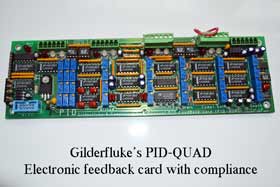
Off the shelf animatronic show control systems are available for many different size shows and have a range of budgets. The big boys of animatronic show control, Alcorn McBride and Gilderfluke, offer control for almost unlimited show sizes. Smaller, hobby level show control producers such as Blue Point Engineering, EFX-TEK (Parallax), and Brookshire offer systems used in many smaller figures, shows and haunted houses. Gilderfluke also offers smaller show controllers at a reasonable cost.
![]()
The essential components needed for animatronic show control include a control board, something to animate (pneumatic cylinders, hydraulics, relays, motors, servos, lights, fog machine, etc.) and a method of programming the show. Some inexpensive show control boards like Blue Point Engineering's Wizard boards, EFX-TEK's EZ-8 board or Gilderfluke's BR-minibrick8 or BR-minibrick4 have push buttons on the board which allow programming. This method of programming can be crude, but is acceptable for very simple shows. Show control programs allow greater control and flexibility of the final product. The most popular animatronic show control software includes Brookshire software VSA, Gilderfluke PC-MACS (free), and Alcorn McBride WinScript (Free). Visual basic or other custom programming can also be used for control boards directly wired to a computer during show playback or stand-alone boards with an embedded microcontroller. The Arduino platform, has a growing number of shields (add-on boards) and sketches (programs) which are targeted for use for animatronics. The standard programming versions of the most powerful show control software is free, offered by both Gilderfluke and Alcorn McBride. These companies can offer the software for free since they really only work with the control boards they sell. Advanced programming versions of both of these software packages, however, are not free, although these features are not necessary for smaller shows.
Control boards typically have 3 different types of output including digital, analog, and servo (PWM). Digital outputs provide simple on-off control. Analog outputs provide the most control over motor, valves and lights, but are more expensive. Pulse Width Modulation (PWM) outputs control the speed and position of servo motors. Additional types of show output that some control boards can handle are MIDI, serial device strings, video, audio, and DMX for professional stage lighting or other DMX devices. Although there are some good examples of animatronic figures that use only light and sound to provide the illusion of animation, an animatronic figure typically has movement. There are different ways that designers have developed to make a figure move. DC motors, stepper motors, servo motors, hydraulic and pneumatic cylinders are all popular options for bringing an animatronic figure to life. The most  sophisticated animatronic figures use analog servo control valves with electronic feedback loops or higher level PID loops with compliance. These type of systems can provide very life-like movement, but are also costly for both the analog servo valves and the control hardware.
sophisticated animatronic figures use analog servo control valves with electronic feedback loops or higher level PID loops with compliance. These type of systems can provide very life-like movement, but are also costly for both the analog servo valves and the control hardware.
Resources:
Alcorn McBride show controllers
Gilderfluke show controllers
Blue Point Engineering show controllers
Arduino as a show controller
Basic Stamp as a show controller
Servo motor controllers
